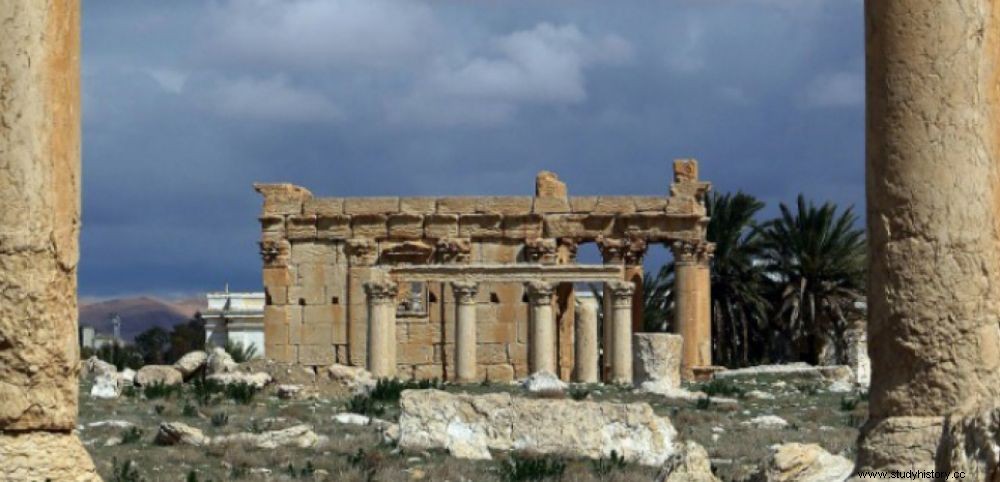 The temple of Baalshamin, seen between two Corinthian columns, on March 14, 2014 in the ancient city of Palmyra, in Syria
The temple of Baalshamin, seen between two Corinthian columns, on March 14, 2014 in the ancient city of Palmyra, in Syria INHUMAN. Daesh jihadists have again attacked a global archaeological treasure by blowing up a famous temple in the ancient city of Palmyra, Syria, classified as a world heritage site. Less than a week ago, the extremist group beheaded the former head of Antiquities of Palmyra, Khaled al-Assaad, 82, renowned worldwide for his knowledge of this unique ancient site. Unesco, France and the United States have denounced a "brutal" murder perpetrated by "barbarians".
ISIS, which has already destroyed several archaeological gems in Iraq, seized Palmyra in May 2015, nicknamed "the pearl of the desert ", arousing serious fears from Unesco and the international community. "Daesh (acronym in Arabic for the Islamic State group) today placed a large quantity of explosives in the temple of Baalshamin before doing so explode. The building is largely destroyed "Syria's director general of antiquities and museums, Maamoun Abdulkarim, told AFP on Sunday.

Location of Baalshamin Temple, destroyed by ISIS looters. © AFP
He said that "the 'cella' (enclosed part of the temple) was destroyed and the columns around it collapsed ".
"This destruction was predictable , laments Fabrice Balanche, Lecturer at Lyon 2 University and director of the Group for Research and Studies on the Mediterranean and the Middle East (GREMMO) at the MSH Maison de l'Orient et de la Méditerranée. This temple dates back to pre-Islamic times, and was once dedicated to the worship of the sun god. It was therefore one of the sites considered "pagan" that it was, according to Daesh, necessary to eliminate " continues Fabrice Balanche. "This destruction follows that of two small Shiite mausoleums that the jihadists destroyed near Palmyra during the summer " he clarifies.
Our darkest predictions are coming true
The temple of Baalshamin began to be erected in the year 17 and was enlarged and embellished by the Roman emperor Hadrian in 130. Baalshamin is the Phoenician sky god. It is the most important sanctuary after that of Bêl, according to the Louvre Museum in Paris. Baalshamin is associated with Aglibôl (moon god) and his younger brother Malkbêl (sun god). Unesco had already protested on July 3, 2015 against the destruction of works of art in Palmyra."The destruction of funerary busts from Palmyra, in a public square, in front of crowds and children that the 'we are summoned to the ransacking of their heritage is a spectacle of chilling perversity ", denounced its director Irina Bokova. "Our darkest predictions are unfortunately coming true ", lamented Mr. Abdulkarim. The jihadists "committed executions in the ancient theater, they destroyed in July the famous statue of the Lion of Athena, which was at the entrance of the museum of Palmyra, and turned the museum into a courthouse and a prison ", he continued.
The Syrian Observatory for Human Rights (OSDH) has confirmed the destruction of this historic monument by IS, which considers pre-Islamic religious works, including statues, as idolatry. After taking Palmyra from Syrian regime forces, IS had executed in and outside the city more than 200 people, including 20 shot dead in the ancient theatre.
The jihadists, who control large swaths of Iraqi and Syrian territory, destroyed in April in Iraq with bulldozers, pickaxes and explosives the archaeological site of Nimroud, jewel of the Assyrian empire founded in the 13th century. They also attacked Hatra - a 2,000-year-old city from the Roman period - and the Mosul museum in northern Iraq. More than 300 Syrian historical sites have been damaged, destroyed or looted during the conflict that began more than four years ago, according to the UN.
